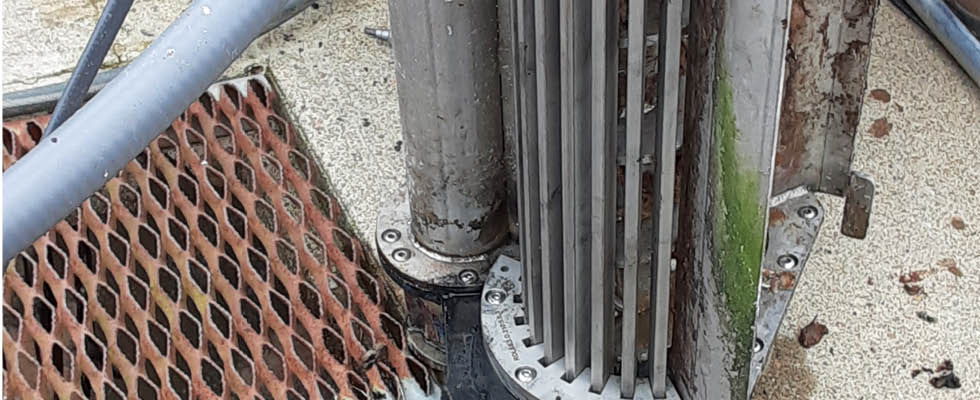
The Schuylkill County Municipal Authority (SCMA), Seiders Hill Wastewater Treatment Plant serves residential and institutional users in Pottsville, Pennsylvania. Flows into the headworks range from 13,000 gallons per day to 20,000 gallons per day at the plant, which is one of seven operated by SCMA in the region.
The Challenge
Like many treatment facilities today, the Seiders Hill plant was plagued by chronic clogging of equipment caused by flushable wipes, rags and other non-dissolvable solids that enter a sanitary sewer system. The plant provides service to a long-term care facility, an assisted living center and a health care provider office. Clogging of the energy efficient and quiet (EQ) pumps and aeration return lines were problems. The plant was equipped with a small grinder designed to macerate influent debris.
However, this did not remove the wipes; it merely shredded them into smaller pieces, which remained in the waste stream. Downstream, these ground-up pieces would combine with fats, oils and grease and reconstitute into clumps, which would then clog the pumps and force shutdowns so that staff could clear the pumps.
Furthermore, grease clumps can interfere with the clarification and digestion processes, so plant staff used pool skimmers to manually clean the EQ tank and clarifiers multiple times a week, removing the macerated debris before it could impact effluent quality. The process was time-consuming and took plant staff away from other operational tasks. With multiple treatment plants and 30 pumping stations to manage and maintain, this additional maintenance and time spent clearing the EQ pumps placed unnecessary strain on the SCMA staff.
The Solution
Operations Manager Jesse Weiss researched potential solutions but found few alternatives for smaller plants like Seiders Hill, until he learned about a dual auger system. As the name suggests, the unit is comprised of two vertical, electrically driven, counter-rotating augers that catch, dewater, compact and remove rags, wipes and other debris from the waste stream, conveying them to a discharge chute or bin for disposal. The unit is fully submersible and compact enough to fit in tight spaces—as small as 17 inches.
While the unit is typically installed in a wet well or maintenance hole, at Seiders Hill, the dual auger system was installed at the plant headworks. An intake screen with a .71-inch bar opening comes standard on the system, a screen size that allows the unit to provide effective removal of wipes and other non-organic debris, while still allowing fecal matter to proceed to downstream treatment.
The Results
Since its installation in March of 2021, the dual auger system has been operating around the clock—more than 15,000 hours of uninterrupted operation and counting. In that time, the plant has not experienced any blockages of the EQ pumps, dramatically improving its resilience. The system is successfully capturing wipes and other debris, pushing them up into the fully contained discharge chute. Removing the material and sending it to the landfill has been a much easier proposition than grinding that same material and allowing it to continue in the waste stream, where it demands much greater attention from staff and jeopardizes the performance of pumps, pipes and tanks.
An Additional Update Further Reduces Maintenance
After almost a year of operating the dual auger system with zero clogging of pumps or aeration return lines, staff at Seiders Hill Wastewater Treatment Plant wondered if they could make the system even better with a smaller intake screen. While clogging was no longer an issue, staff were still having to manually skim the clarifiers to remove small debris that was passing through the .71-inch bar openings on the screen. In February of 2022, they installed a screen with openings about half as large—.34 inches—to see what effect this would have on the process.
The smaller opening easily accommodated the flow of organic matter while removing more debris than the standard screen. Two months after installation, staff reported noticeably fewer clumps and greaseballs in the tanks, reducing the need to skim the clarifiers by 90%. This represented a major improvement on the use of workforce hours.
A Modern Tool to Help Old Systems Solve the New Wipes Problem
In 2019, the National Association of Clean Water Agencies estimated that wipes result in about $441 million a year in additional operating costs at United States clean water utilities. No doubt that number shot up in the years immediately following this report, due to the dramatically increased use of antiseptic wipes in households all over the country to combat the spread of COVID-19.
To avoid massive capital expenses and community disruption, wastewater systems need to keep using existing underground distribution networks, many of which have sections that have been in place for more than a century. However, the modern consumer is fully comfortable flushing wipes and other contaminants into the system. The wastewater system needs solutions, like the dual auger system, that satisfy both challenges.

